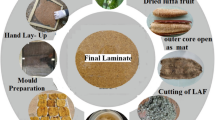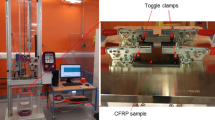Abstract
In this paper we investigated the fatigue damage of a unidirectional flax-reinforced epoxy composite using infrared (IR) thermography. Two configurations of flax/epoxy composites layup were studied namely, [0]16 unidirectional ply orientation and [±45]16. The high cycle fatigue strength was determined using a thermographic criterion developed in a previous study. The fatigue limit obtained by the thermographic criterion was confirmed by the results obtained through conventional experimental methods (i.e., Stress level versus Number of cycles to failure). Furthermore, a model for predicting the fatigue life using the IR thermography was evaluated. The model was found to have a good predictive value for the fatigue life. In order to investigate the mechanism of damage initiation in flax/epoxy composites and the damage evolution, during each fatigue test we monitored the crack propagation for a stress level and at different damage stages, a direct correlation between the percentage of cracks and the mean strain was observed.







Similar content being viewed by others
References
Wambua P, Ivens J, Verpoest I (2003) Natural Fibres: Can They Replace Glass in Fibre Reinforced Plastics? Compos Sci Technol 63:1259–1264. doi:10.1016/S0266-3538(03)00096-4
Fowler PA, Hughes JM, Elias RM (2006) Biocomposites: technology, environmental credentials and market forces. J Sci Food Agric 86:1781–1789. doi:10.1002/jsfa.2558
Katogi H, Shimamura Y, Tohgo K, Fujii T (2012) Fatigue behavior of unidirectional jute spun yarn reinforced pla. Adv Compos Mater 21:1–10. doi:10.1163/156855111x610226
Hughes M, Carpenter J, Hill C (2007) Deformation and fracture behaviour of flax fibre reinforced thermosetting polymer matrix composites. J Mater Sci 42:2499–2511. doi:10.1007/s10853-006-1027-2
Harris B (2003) Fatigue in composites: science and technology of the fatigue response of fibre-reinforced plastics. Woodhead Publishing Limited, Oxford
Vassilopoulos AP (2010) Fatigue Life Prediction of Composites and Composite Structures. Woodhead Publishing Limited, Oxford
Pitarresi G, Patterson E (2003) A review of the general theory of thermoelastic stress analysis. J Strain Anal Eng Des 38:405–417
Kelvin WTB (1878) On the thermoelastic, thermomagnetic, and pyroelectric properties of matter. Philos Mag 5:4–27
Greene R, Patterson E, Rowlands R (2008) In: Sharpe WN Jr (ed) Springer handbook of experimental solid mechanics. Springer, New York
Dulieu-Barton JM (1999) Introduction to thermoelastic stress analysis. Strain 35:35–39. doi:10.1111/j.1475-1305.1999.tb01123.x
Luong MP (1998) Fatigue limit evaluation of metals using an infrared thermographic technique. Mech Mater 28:155–163. doi:10.1016/S0167-6636(97)00047-1
Luong MP (1995) Infrared thermographic scanning of fatigue in metals. Nucl Eng Des 158:363–376. doi:10.1016/0029-5493(95)01043-H
Luong MP (1992) In: Jan E (ed) Thermosense XIVSPIE–the international society for optical engineering. Florida, Orlando
GA Kurilenko (2004) Science and Technology, 2004. KORUS 2004. Proceedingsof the 8th Russian-Korean International Symposium on, Vol. 3. p 32–34
JC Krapez, D Pacou, C Bertin, FOndéedr aérospatiales (2000) Application of lock-in thermography to rapid evaluation of fatigue limit in metals. Office national d″ etudes et de recherches a′ erospatiales
La Rosa G, Risitano A (2000) Thermographic methodology for rapid determination of the fatigue limit of materials and mechanical components. Intern J Fatigue 22:65–73. doi:10.1016/S0142-1123(99)00088-2
Fargione G, Geraci A, La Rosa G, Risitano A (2002) Rapid determination of the fatigue curve by the thermographic method. Intern J Fatigue 24:11–19. doi:10.1016/S0142-1123(01)00107-4
J-C Krapez, D Pacou (2002) Thermography detection of damage initiation during fatigue tests. Thermosense 435–449. doi:10.1117/12.459593
Quaresimin M, Guglielmino E (2000) In: Paolo P (ed) Proceedings of the fifth seminar on experimental techniques and design in composite materials. Trans tech publications, Cagliari
Dattoma V, Marcuccio R, Pappalettere C, Smith GM (2001) Thermographic investigation of sandwich structure made of composite material. NDT E Intern 34:515–520. doi:10.1016/S0963-8695(00)00082-7
Montesano J, Fawaz Z, Bougherara H (2013) Use of infrared thermography to investigate the fatigue behavior of a carbon fiber reinforced polymer composite. Compos Struct 97:76–83. doi:10.1016/j.compstruct.2012.09.046
Karama M (2011) Determination of the fatigue limit of a carbon/epoxy composite using thermographic analysis. Struct Control Health Monit 18:781–789. doi:10.1002/stc.485
Belmares H, Barrera A, Monjaras M (1983) New composite-materials from natural hard fibers. 2. Fatigue studies and a novel fatigue degradation model. Ind Eng Chem Prod Res Develop 22:643–652. doi:10.1021/i300012a024
Gassan J (2002) A study of fibre and interface parameters affecting the fatigue behaviour of natural fibre composites. Compos Part A 33:369–374. doi:10.1016/S1359-835X(01)00116-6
Towo AN, Ansell MP (2008) Fatigue evaluation and dynamic mechanical thermal analysis of sisal fibre-thermosetting resin composites. Compos Sci Technol 68:925–932. doi:10.1016/j.compscitech.2007.08.022
Silva FD, Chawla N, de Toledo RD (2009) An experimental investigation of the fatigue behavior of sisal fibers. Mater Sci Eng a-Struct Mater Prop Microstruct Process 516:90–95. doi:10.1016/j.msea.2009.03.026
Belaadi A, Bezazi A, Bourchak M, Scarpa F (2013) Tensile static and fatigue behaviour of sisal fibres. Mater Des 46:76–83. doi:10.1016/j.matdes.2012.09.048
Gassan J, Bledzki AK (1999) Possibilities for improving the mechanical properties of jute/epoxy composites by alkali treatment of fibres. Compos Sci Technol 59:1303–1309. doi:10.1016/S0266-3538(98)00169-9
Towo AN, Ansell MP (2008) Fatigue of sisal fibre reinforced composites: constant-life diagrams and hysteresis loop capture. Compos Sci Technol 68:915–924. doi:10.1016/j.compscitech.2007.08.021
Shah DU, Schubel PJ, Clifford MJ, Licence P (2013) Fatigue life evaluation of aligned plant fibre composites through S–N curves and constant-life diagrams. Compos Sci Technol 74:139–149. doi:10.1016/j.compscitech.2012.10.015
Liang S, Gning PB, Guillaumat L (2012) A Comparative Study of Fatigue Behaviour of Flax/Epoxy and Glass/Epoxy Composites. Compos Sci Technol 72:535–543. doi:10.1016/j.compscitech.2012.01.011
Astm Standard D3039/D3039 m-08 (2007) Standard test method for tensile properties of polymer matrix composite materials. Am Soc Test Mater
Astm Standard D 3479/D 3479 m-12 (2007), Standard test method for tension–tension fatigue of polymer matrix composite materials. Am Soc Test Mater
Baley C (2002) Analysis of the flax fibres tensile behaviour and analysis of the tensile stiffness increase. Compos Part A 33:939–948. doi:10.1016/S1359-835X(02)00040-4
Spatz H, Kohler L, Niklas K (1999) Mechanical behaviour of plant tissues: composite materials or structures? J Exp Biol 202:3269–3272
Author information
Authors and Affiliations
Corresponding author
Rights and permissions
About this article
Cite this article
El Sawi, I., Fawaz, Z., Zitoune, R. et al. An investigation of the damage mechanisms and fatigue life diagrams of flax fiber-reinforced polymer laminates. J Mater Sci 49, 2338–2346 (2014). https://doi.org/10.1007/s10853-013-7934-0
Received:
Accepted:
Published:
Issue Date:
DOI: https://doi.org/10.1007/s10853-013-7934-0




